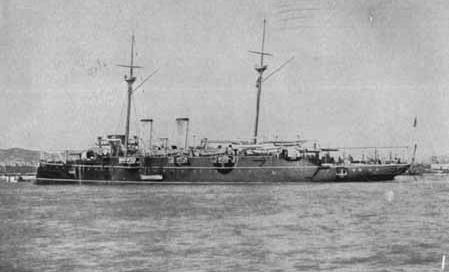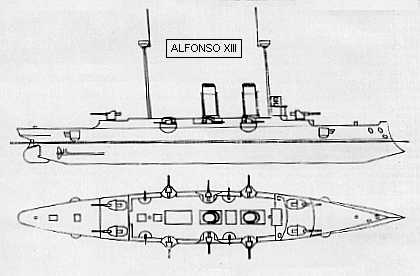


The ALFONSO XIII was not yet fully operational at the outbreak of the Spanish American War in spite of work having begun on her in 1891. She was considered for Camara's squadron, which was to be sent to the Philippines, but her condition would not permit it.
BACKGROUND:
In 1887, the Spanish Navy embarked on a plan to build three protected cruisers of the Chilean ESMERALDA Class, which were designed and constructed in Great Britain. The cruisers, in accordance with Spanish naval doctrine of the period was to have small displacement, heavy armament, and high speed.
The first vessel of this type, REINA REGENTE, was constructed at James and George Thompson's yard at Clydebank, Scotland. The remaining two vessels were to be constructed in Spain based on the plans of the first, making any improvements possible. The REINE REGENTE proved to be an excellent vessel, in spite of being top-heavy from her powerful armament. The weight imbalance may have been a factor in her loss in a storm in 1895.
The next ship in the series was the ALFONSO XIII, which was laid down at Spain's Ferrol shipyard in 1891 based on the REINA REGENTE's design with improvements. One of the improvements was an attempt to correct the weight imbalance problem, but the result was less than satisfactory as the result was slow and lightly armed.
ALFONSO XIII was partially completed by 1896 so that she could be used for training operations. After the outbreak of the Spanish American War and American Admiral Dewey's victory in Manila Bay/Cavite, Spanish Admiral Camara was ordered to form a squadron and steam to Manila to counter the Americans. While Camara was forming his squadron, the ALFONSO XIII was sent to Cadiz on May 7, 1898 to be included with it. Once Camara saw her incomplete condition, he decided not to include her on his later aborted expedition. The ALFONSO XIII remained in Spanish waters as part of a last line of defense.
ALFONSO XIII was officially completed and commissioned on May 18, 1900. Her commissioned career was short, and she was soon dropped from the navy rolls.
ADVANTAGES/DISADVANTAGES:
The ALFONSO XIII was intended to be an improvement to the REINA REGENTE's design. The result was actually the opposite. The armament was downgraded 240 mm guns to 200 mm guns to reduce weight. Her speed was also low. Instead of having a speed of 20 knots like the REINA REGENTE, ALFONSO XIII had a speed of 14 knots. The vessel was unstable in heavy seas.

| Classification: | First Class Protected Cruiser | |
|---|---|---|
| Completed: | Nominally, 1896; Finally May 18, 1900 | |
| Rig |
Three masts
|
|
| Armament: | Four 200 mm/35 mm Honotoria Breechloading guns | |
|
Six 120/35 mm Honotoria Breechloading guns
|
||
| Six 57 mm Nordenfeldt guns | ||
| Six 37 mm Hotchkiss revolving cannons | ||
|
One 42 mm Nordenfeldt gun (landing
parties)
|
||
|
Five torpedo Tubes
|
||
| Contractor: | Spanish Naval Shipyard at Ferrol | |
| Length: | 93.33 meters | |
| Beam: | 15.43 meters | |
| Draft: | 6.05 meters | |
| Depth of hold |
9.91 meters
|
|
| Displacement: | 4826 tons (standard), 5400 tons (full) | |
| Complement: | 420 Officers and Enlisted Men | |
| Engine type: | Engines listed as generating 11,500 hp
powering dual screws (in reality she had much less power) |
|
| Coal Bunker capacity: | 1080 tons | |
| Speed: | 20 knots (in reality, 14 knots) | |
| Armor: | Deck 51-90 mm; slopes 76-110 mm | |
| Cost: |
9 million pesetas
|
Gardiner, Robert, Conway's history of the Ship: Steam, Steel and Shellfire - The Steam Warship 1815-1905. (London: Conway Maritime Press Ltd., 1992).
Kreiser, 1-go Classa s Bronevoy Paluboy Lepanto// Voennie Floti i Morskaya Spravochnaya Knizhka na 1897 god. (SPb: Tipographia by Edward Goppe), 417-419.
Mitiuckov, N. V., Ispanskie Bronepalubnie Kreisera Tipa Reina Regente. (Breeze, 1997 #1-S) 19-28.
Poncet, Jose, Spanish historian (provided images).
Wilson, H. W., Downfall of Spain Naval History of the Spanish Amercan War. (London: Sampson, Low, Mariston Co., 1900) 454.